初中英语时态和语态表格
- 格式:doc
- 大小:59.50 KB
- 文档页数:1
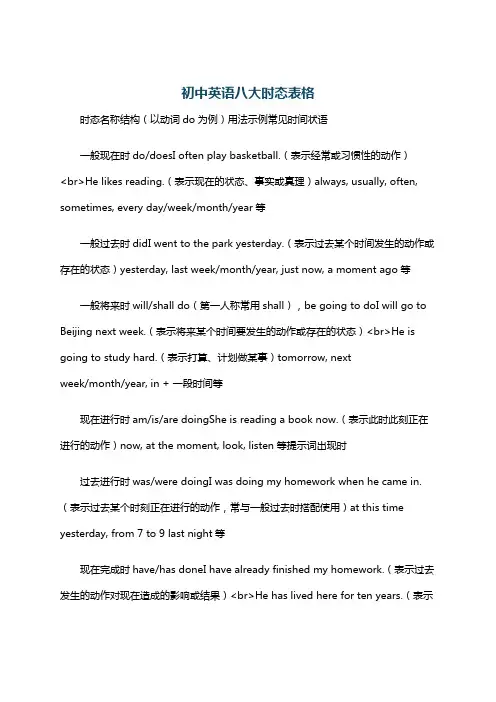
初中英语八大时态表格时态名称结构(以动词do为例)用法示例常见时间状语一般现在时do/doesI often play basketball.(表示经常或习惯性的动作)<br>He likes reading.(表示现在的状态、事实或真理)always, usually, often, sometimes, every day/week/month/year等一般过去时didI went to the park yesterday.(表示过去某个时间发生的动作或存在的状态)yesterday, last week/month/year, just now, a moment ago等一般将来时will/shall do(第一人称常用shall),be going to doI will go to Beijing next week.(表示将来某个时间要发生的动作或存在的状态)<br>He is going to study hard.(表示打算、计划做某事)tomorrow, nextweek/month/year, in + 一段时间等现在进行时am/is/are doingShe is reading a book now.(表示此时此刻正在进行的动作)now, at the moment, look, listen等提示词出现时过去进行时was/were doingI was doing my homework when he came in.(表示过去某个时刻正在进行的动作,常与一般过去时搭配使用)at this time yesterday, from 7 to 9 last night等现在完成时have/has doneI have already finished my homework.(表示过去发生的动作对现在造成的影响或结果)<br>He has lived here for ten years.(表示过去已经开始,持续到现在的动作或状态)already, yet, just, ever, never, for + 时间段, since + 时间点等过去完成时had doneWhen I got to the station, the train had already left.(表示在过去某个时间或动作之前已经发生或完成的动作,即“过去的过去”)by the end of last year, before + 一般过去时的句子等将来进行时will be doingI will be having a meeting at this time tomorrow.(表示将来某个时刻或时间段正在进行的动作)at this time tomorrow等。
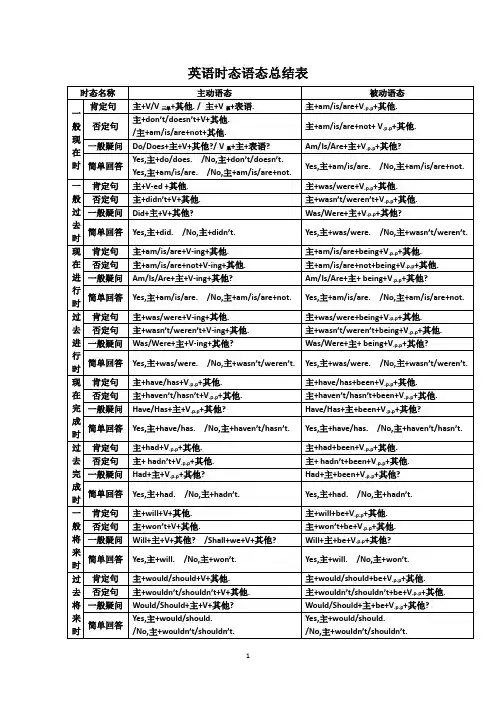
英语时态语态总结表Ⅰ. 英语八种时态归纳复习时态是英语学习中一个至关重要的内容,广大初中学生在实际运用时,往往对时态总是倍感棘手,下面我们就归纳复习一下这几种时态。
一、一般现在时:概念:经常、反复发生的动作或行为及现在的某种状况。
时间状语:always, usually, often, sometimes, every week (day, year, month…), once a week, on Sundays, etc.基本结构:①be动词;②行为动词否定形式:①am/is/are+not;②此时态的谓语动词若为行为动词,则在其前加don't,如主语为第三人称单数,则用doesn't,同时还原行为动词。
一般疑问句:①把be动词放于句首;②用助动词do提问,如主语为第三人称单数,则用does,同时,还原行为动词。
二、一般过去时:概念:过去某个时间里发生的动作或状态;过去习惯性、经常性的动作、行为。
时间状语:ago, yesterday, the day before yesterday, last week(year, night, month…), in 1989, just now, at the age of 5, one day, long long ago, once upon a time, etc.基本结构:①be动词;②行为动词否定形式:①was/were+not;②在行为动词前加didn't,同时还原行为动词。
一般疑问句:①was或were放于句首;②用助动词do的过去式did 提问,同时还原行为动词。
三、现在进行时:概念:表示现阶段或说话时正在进行的动作及行为。
时间状语:now, at this time, these days, etc.基本结构:am/is/are+doing否定形式:am/is/are+not+doing.一般疑问句:把be动词放于句首。

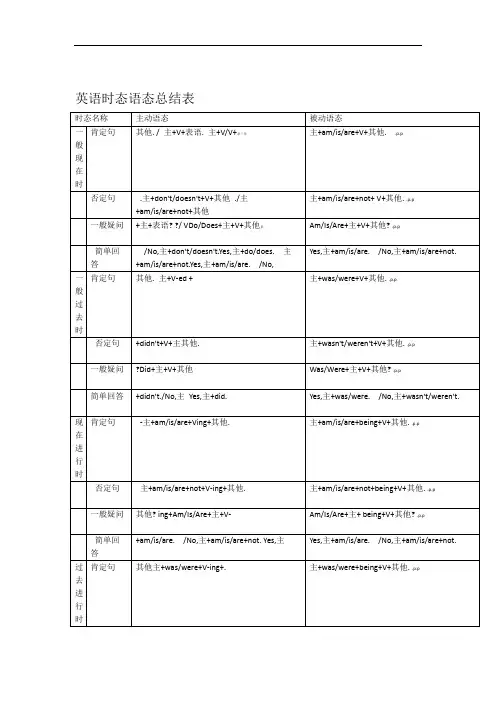
英语时态语态总结表1. 英语八种时态归纳复习Ⅰ时态是英语学习中一个至关重要的内容,广大初中学生在实际运用时,往往对时态总是倍感棘手,下面我们就归纳复习一下这几种时态。
一、一般现在时:概念:经常、反复发生的动作或行为及现在的某种状况。
时间状语:always, usually, often, sometimes, every week (day, year, month…), once a week, on Sundays,etc.be动词;②行为动词基本结构:①如主语don't,am/is/are+not;②此时态的谓语动词若为行为动词,则在其前加否定形式:①,同时还原行为动词。
为第三人称单数,则用doesn't提问,如主语为第三人称单数,则用动词放于句首;②用助动词do一般疑问句:①把be ,同时,还原行为动词。
does二、一般过去时:概念:过去某个时间里发生的动作或状态;过去习惯性、经常性的动作、行为。
), in 1989, …时间状语:ago, yesterday, the day before yesterday, last week(year, night, month just now, at the age of 5, one day, long long ago, once upon a time, etc.动词;②行为动词基本结构:①be②在行为动词前加was/were+not;didn't,同时还原行为动词。
否定形式:①提问,同时还原行为did 的过去式或waswere放于句首;②用助动词do一般疑问句:①动词。
三、现在进行时:2概念:表示现阶段或说话时正在进行的动作及行为。
时间状语:now, at this time, these days, etc.基本结构:am/is/are+doing否定形式:am/is/are+not+doing.一般疑问句:把be动词放于句首。
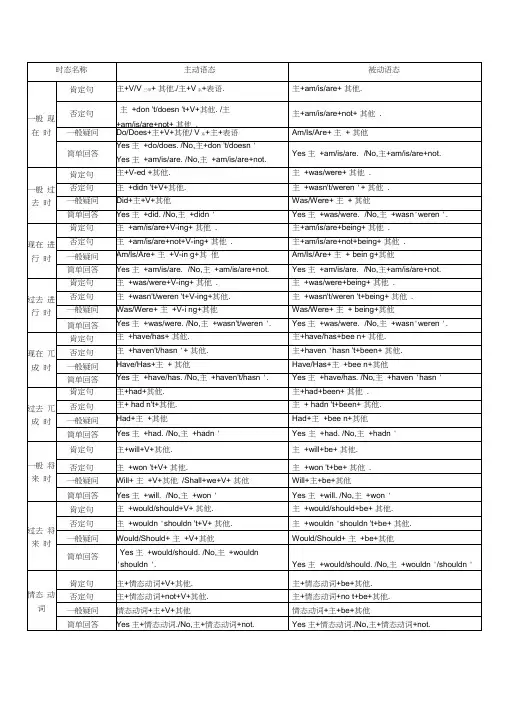

初中时态语态总结表格初中时态语态总结表格动词形式一般现在时一般过去时一般将来时完成时态进行时态被动语态一般形式 V原形+s/es V-ed will/shall+V原形have/has+V过去分词 am/is/are+V-ing am/is/are+V过去分词例句 She plays basketball. He studied English yesterday. I will go to the beach tomorrow. They have finished their homework. I am watching TV now. The book was written by Mark.时态解释表示现在发生的动作或状态。
表示过去发生的动作或状态。
表示将来发生的动作或状态。
表示过去发生并一直延续到现在的动作或状态。
表示说话时正在进行的动作或状态。
表示动作的承受者。
一般性使用主语+动词主语+动词ed 主语+will/shall+动词主语+have/has+动词ed 主语+am/is/are+动词ing 主语+am/is/are+动词过去分词一般疑问句助动词(do/does)/be动词(is/am/are)+主语+动词助动词(did)/be动词(was/were)+主语+动词助动词(will/shall)/be动词(is/am/are)+主语+动词助动词(have/has)/be动词(is/am/are)+主语+动词ed 助动词(am/is/are)/be动词(is/am/are)+主语+ 动词ing 助动词(am/is/are)/be动词(is/am/are)+主语+动词过去分词特殊疑问句疑问词+助动词(do/does)/be动词(is/am/are)+主语+动词疑问词+助动词(did)/be动词(was/were)+主语+动词疑问词+助动词(will/shall)/be 动词(is/am/are)+主语+动词疑问词+助动词(have/has)/be动词(is/am/are)+主语+动词ed 疑问词+助动词(am/is/are)/be动词(is/am/are)+主语+ 动词ing 疑问词+助动词(am/is/are)/be动词(is/am/are)+主语+动词过去分词否定句主语+助动词(do not/does not)/be动词(is/am/are not)+动词主语+助动词(did not)/be动词(was/were not)+动词主语+助动词(will/shall not)/be动词(is/am/are not)+动词主语+助动词(have/has not)/be 动词(is/am/are not)+动词ed 主语+助动词(am not/is not/are not)/be动词(is/am/are not)+动词ing 主语+助动词(am not/is not/are not)/be动词(is/am/are not)+动词过去分词情态动词主语+情态动词+动词原形主语+情态动词+动词原形主语+will/shall+情态动词+动词原形主语+have/has+情态动词+动词原形主语+am/is/are+情态动词+ 动词ing 主语+am/is/are+情态动词+动词过去分词现在进行时主语+am/is/are+V-ing 主语+was/were+V-ing 主语+will/shall+be+V-ing 主语+have/has+been+V-ing - -过去进行时主语+was/were+V-ing -- - - -将来进行时主语+will/shall+be+V-ing -- - - -完成进行时主语+have/has+been+V-ing 主语+had+been+V-ing - -- -被动语态主语+am/is/are+V过去分词主语+was/were+V过去分词主语+will/shall+be+V过去分词主语+have/has+been+V过去分词主语+am/is/are+being+V过去分词主语+am/is/are+V过去分词。
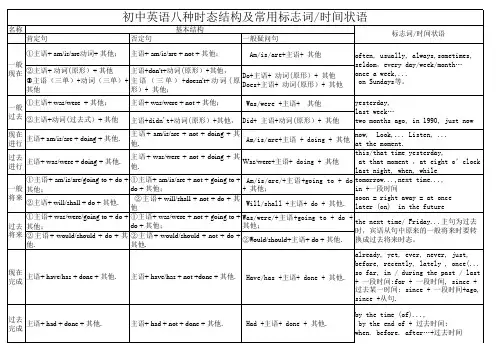
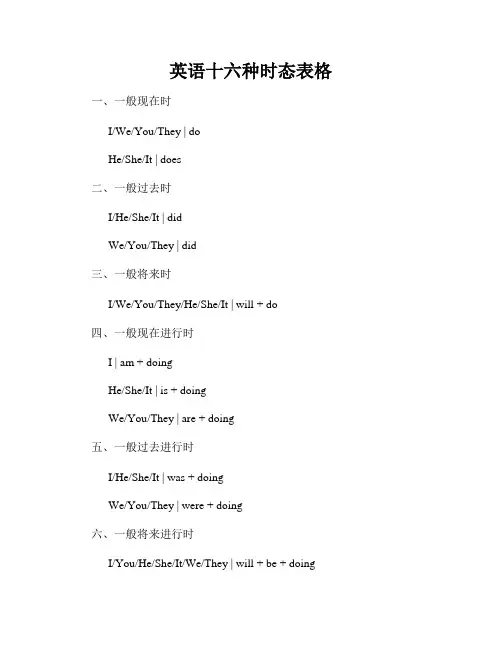
英语十六种时态表格一、一般现在时I/We/You/They | doHe/She/It | does二、一般过去时I/He/She/It | didWe/You/They | did三、一般将来时I/We/You/They/He/She/It | will + do四、一般现在进行时I | am + doingHe/She/It | is + doingWe/You/They | are + doing五、一般过去进行时I/He/She/It | was + doingWe/You/They | were + doing六、一般将来进行时I/You/He/She/It/We/They | will + be + doing七、一般现在完成时I/You/We/They/He/She/It | have/has + done八、一般过去完成时I/You/We/They/He/She/It | had + done九、一般将来完成时I/You/We/They/He/She/It | will have + done十、现在完成进行时I/You/We/They/He/She/It | have/has been + doing 十一、过去完成进行时I/You/We/They/He/She/It | had been + doing十二、将来完成进行时I/You/We/They/He/She/It | will have been + doing 十三、现在完成时I/You/We/They/He/She/It | have/has + done十四、过去完成时I/You/We/They/He/She/It | had + done十五、将来完成时I/You/We/They/He/She/It | will have + done十六、过去将来时I/You/He/She/It/We/They | would + do以上是英语中的十六种时态及其对应的动词形式。
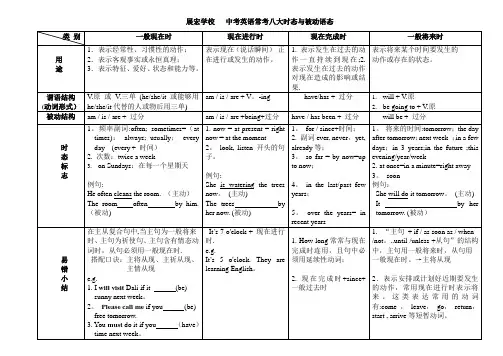
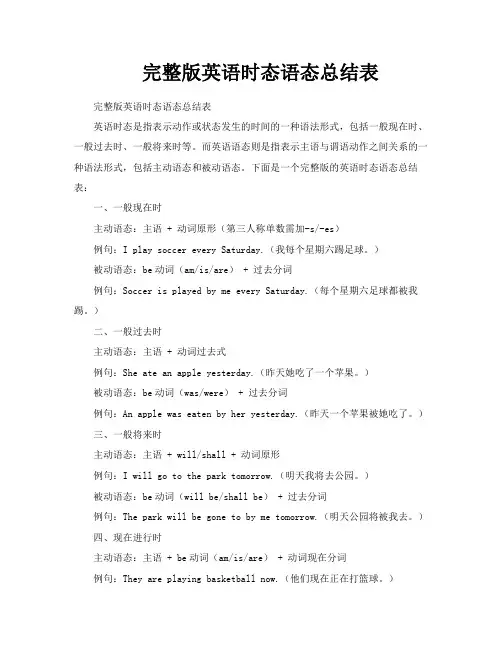
完整版英语时态语态总结表完整版英语时态语态总结表英语时态是指表示动作或状态发生的时间的一种语法形式,包括一般现在时、一般过去时、一般将来时等。
而英语语态则是指表示主语与谓语动作之间关系的一种语法形式,包括主动语态和被动语态。
下面是一个完整版的英语时态语态总结表:一、一般现在时主动语态:主语 + 动词原形(第三人称单数需加-s/-es)例句:I play soccer every Saturday.(我每个星期六踢足球。
)被动语态:be动词(am/is/are) + 过去分词例句:Soccer is played by me every Saturday.(每个星期六足球都被我踢。
)二、一般过去时主动语态:主语 + 动词过去式例句:She ate an apple yesterday.(昨天她吃了一个苹果。
)被动语态:be动词(was/were) + 过去分词例句:An apple was eaten by her yesterday.(昨天一个苹果被她吃了。
)三、一般将来时主动语态:主语 + will/shall + 动词原形例句:I will go to the park tomorrow.(明天我将去公园。
)被动语态:be动词(will be/shall be) + 过去分词例句:The park will be gone to by me tomorrow.(明天公园将被我去。
)四、现在进行时主动语态:主语 + be动词(am/is/are) + 动词现在分词例句:They are playing basketball now.(他们现在正在打篮球。
)被动语态:be动词(am/is/are) + being + 过去分词例句:Basketball is being played by them now.(篮球现在正在被他们打。
)五、过去进行时主动语态:主语 + was/were + 动词现在分词例句:He was reading a book at 8 p.m. yesterday.(昨天晚上8点他在读书。

英语时态语态总结表1. 英语八种时态归纳复习Ⅰ时态是英语学习中一个至关重要的内容,广大初中学生在实际运用时,往往对时态总是倍感棘手,下面我们就归纳复习一下这几种时态。
一、一般现在时:概念:经常、反复发生的动作或行为及现在的某种状况。
时间状语:always, usually, often, sometimes, every week (day, year, month…), once a week, on Sundays,etc.be动词;②行为动词基本结构:①如主语don't,am/is/are+not;②此时态的谓语动词若为行为动词,则在其前加否定形式:①,同时还原行为动词。
为第三人称单数,则用doesn't提问,如主语为第三人称单数,则用动词放于句首;②用助动词do一般疑问句:①把be ,同时,还原行为动词。
does二、一般过去时:概念:过去某个时间里发生的动作或状态;过去习惯性、经常性的动作、行为。
), in 1989, …时间状语:ago, yesterday, the day before yesterday, last week(year, night, month just now, at the age of 5, one day, long long ago, once upon a time, etc.动词;②行为动词基本结构:①be②在行为动词前加was/were+not;didn't,同时还原行为动词。
否定形式:①提问,同时还原行为did 的过去式或waswere放于句首;②用助动词do一般疑问句:①动词。
三、现在进行时:2概念:表示现阶段或说话时正在进行的动作及行为。
时间状语:now, at this time, these days, etc.基本结构:am/is/are+doing否定形式:am/is/are+not+doing.一般疑问句:把be动词放于句首。
六种时态一览表时态一般现在时一般过去时现在进行时过去进行时一般将来时现在完成时用法时间标志构成方式表示常性生的表示去某个表示在或段正表示去某正在表示将来某个要作、性作或客生的作或存在的状在行或生的行的作或存在的状生的作或存在的真理、科学事等。
作。
状。
度副: always,the day before now, at the moment, at just then,at this tomorrow ; the dayoften , usually ,yesterday,yesterday,this moment, just moment yesterday, after tomorrow;nextsometimes,seldom,last/yesterday night,now,look, listen, at yesterday morning/day/week/month/year/never;everyday,every last week, last month,present, these days,afternoon/evening, at term; soon; in a fewweek, every month, last year,last term;this week that time,this minutes; by+ 年份 ;every year 等in/on+ 去 ;morning,the whole in+状; in the+ago; just now, at the morning,all day future; in futureage of 5, one day, long yesterday, from+long ago; once upon a数 +to+数+lasttime night, those days 或以when, while 引的是一般去的状等。
英语时态语态总结表时态名称主动语态被动语态一般现在时肯定句主+V/V三单+其他. / 主+V系+表语. 主+am/is/are+V.p.p+其他.否定句主+don’t/doesn’t+V+其他./主+am/is/are+not+其他.主+am/is/are+not+ V.p.p+其他.一般疑问Do/Does+主+V+其他?/ V系+主+表语? Am/Is/Are+主+V.p.p+其他?简单回答Yes,主+do/does. /No,主+don’t/doesn’t.Yes,主+am/is/are. /No,主+am/is/are+not.Yes,主+am/is/are. /No,主+am/is/are+not.一般过去时肯定句主+V-ed +其他. 主+was/were+V.p.p+其他.否定句主+didn’t+V+其他. 主+wasn’t/weren’t+V.p.p+其他.一般疑问Did+主+V+其他? Was/Were+主+V.p.p+其他?简单回答Yes,主+did. /No,主+didn’t.Yes,主+was/were. /No,主+wasn’t/weren’t.现在进行时肯定句主+am/is/are+V-ing+其他. 主+am/is/are+being+V.p.p+其他.否定句主+am/is/are+not+V-ing+其他. 主+am/is/are+not+being+V.p.p+其他.一般疑问Am/Is/Are+主+V-ing+其他? Am/Is/Are+主+ being+V.p.p+其他?简单回答Yes,主+am/is/are. /No,主+am/is/are+not. Yes,主+am/is/are. /No,主+am/is/are+not.过去进行时肯定句主+was/were+V-ing+其他. 主+was/were+being+V.p.p+其他.否定句主+wasn’t/weren’t+V-ing+其他. 主+wasn’t/weren’t+being+V.p.p+其他.一般疑问Was/Were+主+V-ing+其他? Was/Were+主+ being+V.p.p+其他?简单回答Yes,主+was/were. /No,主+wasn’t/weren’t.Yes,主+was/were. /No,主+wasn’t/weren’t.现在完成时肯定句主+have/has+V.p.p+其他. 主+have/has+been+V.p.p+其他.否定句主+haven’t/hasn’t+V.p.p+其他. 主+haven’t/hasn’t+been+V.p.p+其他.一般疑问Have/Has+主+V.p.p+其他? Have/Has+主+been+V.p.p+其他?简单回答Yes,主+have/has. /No,主+haven’t/hasn’t. Yes,主+have/has. /No,主+haven’t/hasn’t.过去完成时肯定句主+had+V.p.p+其他. 主+had+been+V.p.p+其他.否定句主+ hadn’t+V.p.p+其他. 主+ hadn’t+been+V.p.p+其他. 一般疑问Had+主+V.p.p+其他? Had+主+been+V.p.p+其他?简单回答Yes,主+had. /No,主+hadn’t. Yes,主+had. /No,主+hadn’t.一般将来时肯定句主+will+V+其他. 主+will+be+V.p.p+其他.否定句主+won’t+V+其他. 主+won’t+be+V.p.p+其他.一般疑问Will+主+V+其他? /Shall+we+V+其他? Will+主+be+V.p.p+其他?简单回答Yes,主+will. /No,主+won’t. Yes,主+will. /No,主+won’t.过去将来时肯定句主+would/should+V+其他. 主+would/should+be+V.p.p+其他.否定句主+wouldn’t/shouldn’t+V+其他. 主+wouldn’t/shouldn’t+be+V.p.p+其他. 一般疑问Would/Should+主+V+其他? Would/Should+主+be+V.p.p+其他?简单回答Yes,主+would/should./No,主+wouldn’t/shouldn’t.Yes,主+would/should./No,主+wouldn’t/shouldn’t.情态动词肯定句主+情态动词+V+其他. 主+情态动词+be+V.p.p+其他.否定句主+情态动词+not+V+其他. 主+情态动词+not+be+V.p.p+其他.一般疑问情态动词+主+V+其他?情态动词+主+be+V.p.p+其他?简单回答Yes,主+情态动词. /No,主+情态动词+not. Yes,主+情态动词. /No,主+情态动词+not.Ⅰ. 英语八种时态归纳温习时态是英语学习中一个至关重要的内容,广大初中学生在实际运用时,往往对时态总是倍感棘手,下面我们就归纳温习一下这几种时态。
状态语态时间现在过去将来过去将来一般主动一般现在时do / does一般过去时did一般将来时shall / will doam / is / are going todo过去将来时should / would dowas / were going to do 被动am / is / are done was / were done shall / will be doneam / is / are going tobe doneshould / would be done进行主动现在进行时am / is / are doing过去进行时was / were doing将来进行时shall / will be doing过去将来进行时should / would be doing 被动am / is / are beingdonewas / were beingdoneshall / will be beingdone无被动语态should / would be beingdone无被动语态完成主动现在完成时have / has done过去完成时had done将来完成时shall / will have done过去将来完成时should / would have done被动have / has been done had been done shall / will have beendone很少使用被动语态should / would have beendone很少使用被动语态完成主动现在完成进行时have / has beendoing过去完成进行时had been doing将来完成进行时shall / will have beendoing过去将来完成进行时should / would have beendoing英语的及 蓝色字体是8种最常用时态、绿色是比较常用时态、紫色是不常用时态)。